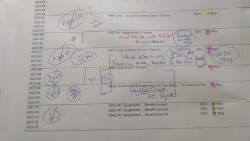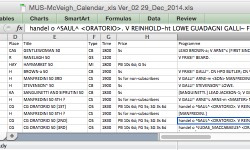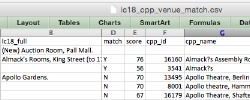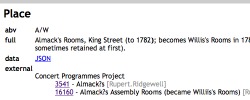Abstract
Spreadsheets are ubiquitous, familiar, often overlooked, and embody vast financial and human investment, not least in their user interface. This paper shows how spreadsheets can be used as an integral part of interactive processes, for activities from simple data entry, to more complex grouping and linking of datasets, both as fully functional prototypes and as part of a final system. They reveal artful digital and physical end-user appropriation; exemplify key design principles including 'appropriate intelligence', ensuring 'smart' technology fits the complete human–computer process; and expose further design issues such as the importance of 'exception' sets.
Keywords: Spreadsheets; appropriation; musicology; digital humanities.
References
- [AE07] Ahmed, E. Ipeirotis, P. and Verykios, V. (2007). Duplicate Record Detection: A Survey. IEEE Transactions on Knowledge and Data Engineering 19 (1):1–16. doi:10.1109/TKDE.2007.9
- [AM08] von Ahn, L., Maurer, B., McMillen, C., Abraham, D. and M. Blum, M. (2008). reCAPTCHA: Human-Based Character Recognition via Web Security Measures. Science, 321(5895):1465–1468. http://science.sciencemag.org/content/321/5895/1465
- Bashford, C., Cowgill, R. and McVeigh, S. (2000). The Concert Life in Nineteenth-Century London Database, in Nineteenth-Century British Music Studies, 2, ed. by J. Dibble and B. Zon (Aldershot: Ashgate, 2000), 1-12.
- [BC06] Berners-Lee, T., Chen, Y., Chilton, L., Connolly, D., Dhanaraj, R., Hollenbach, J., Lerer, A. and Sheets, D. (2006). Tabulator: Exploring and Analyzing linked data on the Semantic Web, Proc. SWUI06 http://swui.semanticweb.org/swui06/papers/Berners-Lee/Berners-Lee.pdf
- [BG07] Bhattacharya, I. and Getoor, L. (2007). Collective entity resolution in relational data. ACM Trans. Knowl. Discov. Data, 1(1):5. doi: 10.1145/1217299.1217304
- [BL06] Bilgic, M., Licamele, L., Getoor, L., and Shneiderman, B. (2006). D-Dupe: An Interactive Tool for Entity Resolution in Social Networks. Proc. IEEE Symposium on Visual Analytics Science and Technology 2006 (VAST '06). http://linqs.cs.umd.edu/basilic/web/Publications/2006/bilgic:vast06/
- [BR05] Boudreau, M. and Robey, D. (2005). Enacting Integrated Information Technology: A Human Agency Perspective. Organization Science, 16(1):3-18. http://www.jstor.org/stable/25145945
- [BG87] Brown, P. and Gould, J. (1987). An experimental study of people creating spreadsheets. ACM Trans. Inf. Syst. 5, 3 (July 1987), 258-272. doi: 10.1145/27641.28058
- [CM15] Chang, K. and Myers, B. (2015). A Spreadsheet Model for Handling Streaming Data. In Proc. CHI '15. ACM, 3399-3402. doi:10.1145/2702123.2702587
- Concert Programmes online database. accessed 3/1/2016. http://www.concertprogrammes.org.uk/html/about
- [DB00] Dix, A., Beale, R. and Wood, A. (2000). Architectures to make Simple Visualisations using Simple Systems. Proc. AVI2000, ACM, pp. 51-60. http://alandix.com/academic/papers/avi2000/
- [D07] Dix, A. (2007). Designing for appropriation. In Proc. BCS-HCI '07 Vol. 2. BCS, UK, pp.27-30. http://ewic.bcs.org/content/ConWebDoc/13347
- [DC14] Dix, A., Cowgill, R., Bashford, C., McVeigh, S. and Ridgewell, R. (2014). Authority and Judgement in the Digital Archive. In The 1st International Digital Libraries for Musicology workshop (DLfM 2014), ACM/IEEE Digital Libraries conference 2014, London 12th Sept. 2014. http://www.hcibook.com/alan/papers/DLfM-2014/
- [D46] Dunn, H. (1946). Record Linkage. American Journal of Public Health 36 (12): pp. 1412–1416. doi:10.2105/AJPH.36.12.1412
- [GH96] Galletta, D., Hartzel, K., Johnson, S., Joseph, J. and Rustagi, S. (1996). Spreadsheet presentation and error detection: an experimental study. J. Manage. Inf. Syst. 13(3):45-63. doi: 10.1080/07421222.1996.11518133
- [GS10] Di Gioia, M., Scannapieco, M. and Beneventano, D. (2010). Object Identification across Multiple Sources. Proc. of the Eighteenth Italian Symposium on Advanced Database Systems, SEBD 2010, Rimini, Italy, June 20-23, 2010. http://docplayer.net/959117-Sonia-bergamaschi-stefano-lodi-riccardo-martoglia-claudio-sartori-sebd-2010.html
- [HG94] Hendry, D. and Green, T. (1994). Creating, comprehending and explaining spreadsheets. Int. J. Hum.-Comput. Stud. 40, 6 (June 1994), 1033-1065. doi:10.1006/ijhc.1994.1047
- [K84] Kay, A. (1984) Computer Software. Scientific American 251, 52–59. doi:10.1038/scientificamerican0984-52
- [K07] Kennedy, M. (2007). National Archive project to avert digital dark age. The Guardian, 4 July 2007. http://www.theguardian.com/technology/2007/jul/04/news.uknews
- [K97] Kuny, T. (1997). A Digital Dark Ages? Challenges in the of Electronic Prevention Information. 63rd IFLA (International Federation of Library Associations and Institutions) Council and General Conference.
- McVeigh, S. (1992–2014) Calendar of London Concerts 1750–1800. (Dataset) Goldsmiths, University of London. http://research.gold.ac.uk/10342/
- [M90] Monk, A. (1990). Action-effect rules: a technique for evaluating an informal specification against principles. Behaviour & Information Technology. 9(2):147–155. doi: 10.1080/01449299008924231
- [NM90] Nardi, B. and Miller, J. (1990). An ethnographic study of distributed problem solving in spreadsheet development. Proc CSCW '90. ACM,, 197-208. doi: 10.1145/99332.99355
- [NA12] Nikolov, A., d'Aquin, M., and Motta, E. (2012). Unsupervised learning of link discovery configuration. In Proc. ESWC'12, Springer-Verlag, Berlin, Heidelberg, 119-133. doi: 10.1007/978-3-642-30284-8_15
- [PB03] Peyton Jones, S., Blackwell, A. and Burnett, M. (2003). A user-centred approach to functions in Excel. In Proc. ICFP '03, ACM, 165-176. doi:10.1145/944705.944721
- [RS06] Rendle, S. and Schmidt-Thieme. L. (2006). Object identification with constraints. Data Mining, 2006., 1026–1031, http://www.ismll.uni-hildesheim.de/pub/pdfs/Rendle_SchmidtThieme2006-Object_Identification_with_Constraints.pdf
- [ST15] Scannapieco, M., Tosco, L., Valentino, L., Mancini, L., Cibella, N., Tuoto T. and Fortini, M. (2015). Relais User's Guide - Version 3.0. Technical Report, Italian National Institute of Statistics (Istat). July 2015, doi:10.13140/RG.2.1.1332.5922
- [SB13] Singh, A., Bhadauria, V., Jain, A. and Gurung, A. (2013). Role of gender, self-efficacy, anxiety and testing formats in learning spreadsheets. Comput. Hum. Behav. 29, 3 (May 2013), 739-746. doi:10.1016/j.chb.2012.11.009
- [T14] Tennison, J. (2014). 2014: The Year of CSV. Open Data Institute. 11 Jan. 2014. http://theodi.org/blog/2014-the-year-of-csv
- [T09] Thorne, S. (2009). A review of spreadsheet error reduction techniques. Communications of the Association for Information Systems 25 (1), 34. http://aisel.aisnet.org/cais/vol25/iss1/34/
|
Figure 1. Printed spreadsheet for working
[zoom image]
Additional Images
Close up of paper annotations
[zoom image]
Complex fields in spreadsheet
[zoom image]
Spreadshet for authority file matching
[zoom image]
Links shown with provenance
[zoom image]




